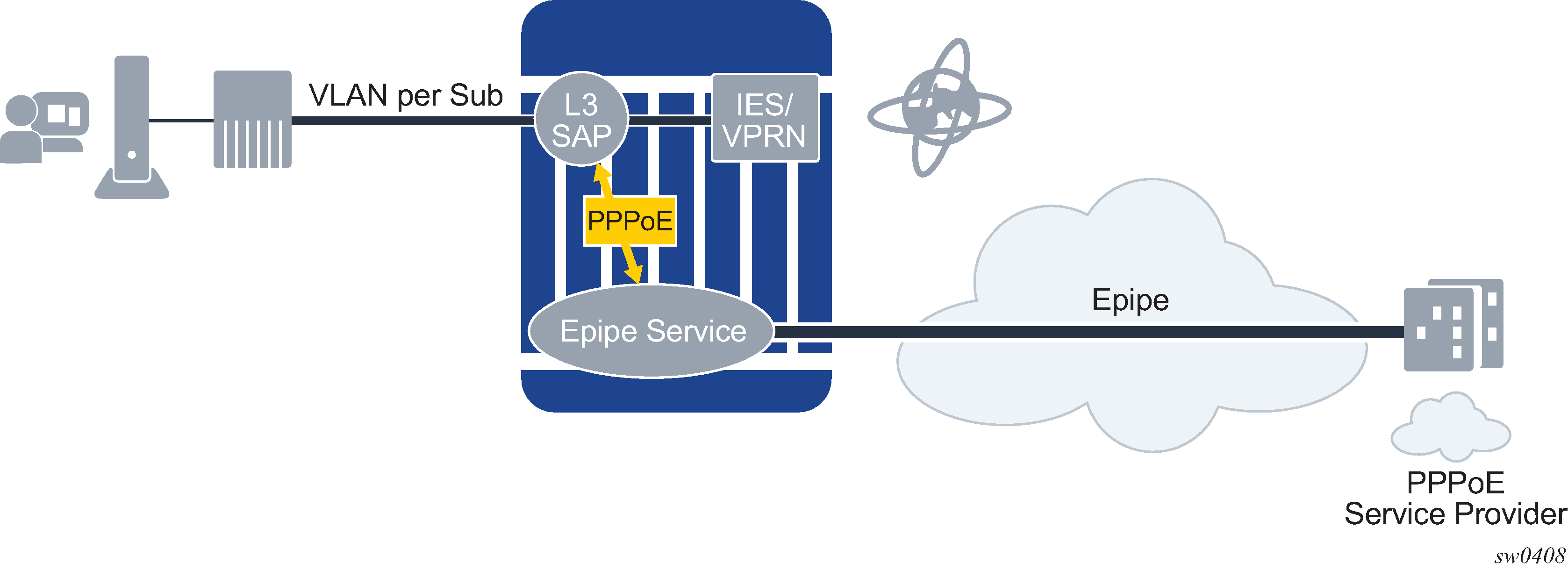The router supports the redirection of PPPoE packets on ingress to a Layer 3 static subscriber SAP and PW-SAPs (for example, bound to an IES or VPRN service) in the upstream direction toward an Epipe service. The Epipe, which is bound to a specific SAP on a group interface of a Layer 3 service, is used to backhaul the PPPoE traffic toward a remote destination, such as, a wholesale service provider. Other non-PPPoE packets are still forwarded to the group interface on the IES or VPRN.
There is a one-to-one mapping from backhaul Epipe to the subscriber. A single backhaul Epipe service per subscriber SAP is supported. Only static configuration of subscriber SAPs is supported.
In the downstream direction, all traffic arriving on the backhaul Epipe is forwarded to the subscriber SAP and merged with IPoE traffic.
This architecture is shown in Figure: Redirection of traffic to Epipe for backhaul.

If the SAP on the Layer 3 service is configured to indicate PPPoE redirection, in addition to ESM anti-spoofing, then the following processing occurs in the upstream direction:
All PPPoE traffic, such as traffic with Ethertype 0x8863 and 0x8864, skips the anti-spoof lookup and is then be forward to a configured Epipe service.
All non-PPPoE is subject to anti-spoofing lookup. If the anti-spoofing fails, then the packet is dropped. Otherwise, processing continues using the host configuration.
The fwd-wholesale context in the Layer 3 SAP is used to configure the forwarding of PPPoE packets toward a specified Epipe service:
config
service
ies | vrpn
subscriber-interface
group-interface
sap 1/1/1:10.20
anti-spoof ...
fwd-wholesale
pppoe 10
exit
The PPPoE option specifies that only packets matching Ethertype 0x8863 and 0x8864 are redirected to the Epipe of service ID '10'. This includes all PPPoE control plane packets. Note that the service IDs specified under fwd-wholesale cannot refer to a vc-switching Epipe service.
When fwd-wholesale is configured to an Epipe with a specified service ID, the system ensures that the Epipe exists and meets all the requirements to participate in the PPPoE redirect. There is no need for additional configuration under the Epipe. For the previous example, only the following configuration is required for the Epipe:
epipe 10 name "10" customer 1 create
service-mtu 1400
spoke-sdp 10:9 create
no shutdown
exit
no shutdown
exit
The system generates a CLI error if a user tries to configure additional SAPs on an Epipe that is already referenced from a fwd-wholesale context.
In the upstream direction, subscriber queues are used for IPoE packets destined for a local host and PPPoE backhaul traffic. However, CPM traffic is not consuming subscriber queue resources; QoS profiles are instantiated while single-sub-parameters profiled-traffic-only is enabled.
In the downstream direction, PPPoE traffic arriving on the Epipe is merged back into the subscriber SAP referencing the Epipe service. ESM traffic from the host uses the subscriber queues that the host is configured to use, and the backhaul traffic uses the SAP queues. If profile-traffic-only is configured, then all traffic uses the SAP queues.
The operational status of the Epipe with a matching service ID can only be up if the corresponding Layer 3 SAP's operational status is up. The operational or administrative status of the Epipe does not affect the status of the Layer 3 service SAP. If the Layer 3 service SAP is up, but the backhaul Epipe is down, then the system continues to redirect packets to the Epipe, but they are dropped by the Epipe service. The status of the Epipe service is indicated in the output of the show>service>service-using command.